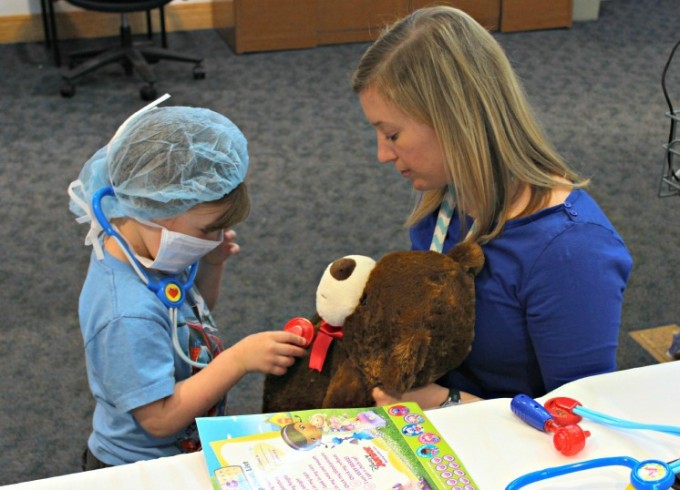Heart Health for Kids
Emily Finnan is a Registered Dietitian in the Clinical Nutrition department at Franciscan Hospital for Children. If you have nutrition-related questions, please email us at info@fhfc.org or call 617-254-3800 x1350.

Did you know that February is American Heart Month? The entire month is dedicated to raising awareness about heart disease which is, unfortunately, the number one cause of death for Americans. This month often kick-starts people to think about their own heart health. Some undergo cholesterol and blood pressure screenings, while others make diet and lifestyle changes. Most heart attacks occur in adults, middle-aged or older, but prevention can start at any age!
Heart disease is complex, with no single cause. Researchers have, however, identified a number of risk factors that make a person more or less likely to develop heart disease. Some risk factors we can’t control – like family history. Others – like high blood cholesterol, high blood pressure, physical inactivity, overweight or obesity, and diabetes – we do have some control over through diet, exercise, and other lifestyle factors.
Our diet and exercise habits start in childhood, A heart-healthy childhood can help prevent the development of these risk factors. Childhood is the ultimate time for heart disease prevention!
Below are a few easy ways that your family can reduce heart disease risk.
1. Get moving
Children five years old or older should get 60 minutes of moderate to vigorous physical activity a day, with vigorous physical activity at least three days a week. Moderate physical activity is any activity that increases the heart rate. Vigorous physical activity is any activity that increases the heart and breathing rate.
60 minutes of daily exercise doesn’t have to happen all at once. 15 minutes of physical activity, four times a day, is just as effective. Physical activity can happen in structured, after-school sports and P.E. classes, or during unstructured play – like jump rope, tag, or climbing on playscapes. It can even mean helping with household chores, like shoveling!
Experts also recommend that parents set limits on sedentary activities or “screen time”. Try and keep these activities, like watching TV and playing video games, to less than 2 hours a day. To break up screen time, try adding physical activity like jumping jacks, sit-ups, or running in place during commercial breaks. Some video games, like Wii Sports, Kinect Sports, Just Dance, and others, incorporate physical activity into game play.
2. Eat a heart-healthy diet
A healthy diet is generally a heart-healthy diet! But there are some specific tips for nutrition that benefit the heart:
- Children should eat plenty of fiber-rich foods like fruits, vegetables, and whole grains.
- Protein is essential for growing children. Fish, poultry, lean meats, and beans are the best heart-healthy sources.
- Drink water or low-fat milk (whole milk for children under two). No-added-sugar juice should be capped at 6 ounces a day. That’s one small glass or juice box per day.
- Choose plant oils and trans-fat-free margarines over butter and lard in cooking.
- Limit sweet treats to an occasional enjoyment versus a daily part of your child’s diet.
- Salty snacks should also be eaten only on occasion. Try seasoning family meals with herbs and spices rather than salt (you can find seasoning ideas here). This can also help shape your child’s taste buds away from salty foods.
- Avoid trans- This fat is found in foods with “partially hydrogenated oil” on the ingredients list. Some foods that can have trans-fat are baked goods (cookies, cakes, biscuits etc.), frozen pizzas, frosting, microwave popcorn, margarines, and other packaged foods. Check ingredient list.
Get your child excited about eating nutritious food by involving them in meal preparation! There are lots of ways to get children involved. Ask your child to help you shop for ingredients, wash produce, peel/chop (for older children), measure and add ingredients, stir, monitor cooking time or progress, and adjust seasonings. Children (including picky eaters) who help make their meal are more likely to eat it – and they may learn a new skill too! Find more tips for picky eaters here.
3. Have and maintain a healthy body weight
The above heart-healthy diet should also be within your child’s calorie needs. That is, enough calories and nutrients to support growth and your child’s activity level, but not too many calories to promote excess weight gain. Your doctor or dietitian can help assess your child’s growth.
Lastly, set a good example. All of these healthy tips can be a part of parents’ routine too. Children look up to their parents and older sibling(s). If the family has healthy eating habits and exercise routines, they will likely too!
If you have more questions about heart disease, or your child’s risk for heart disease, please contact your pediatrician.
Reference: Daniels SR et al. Expert Panel on Integrate Guidelines for Cardiovascular Health and Risk Reduction in Children and Adolescents. National Heart Lung and Blood Institute. October 2012.
View All Blog Stories